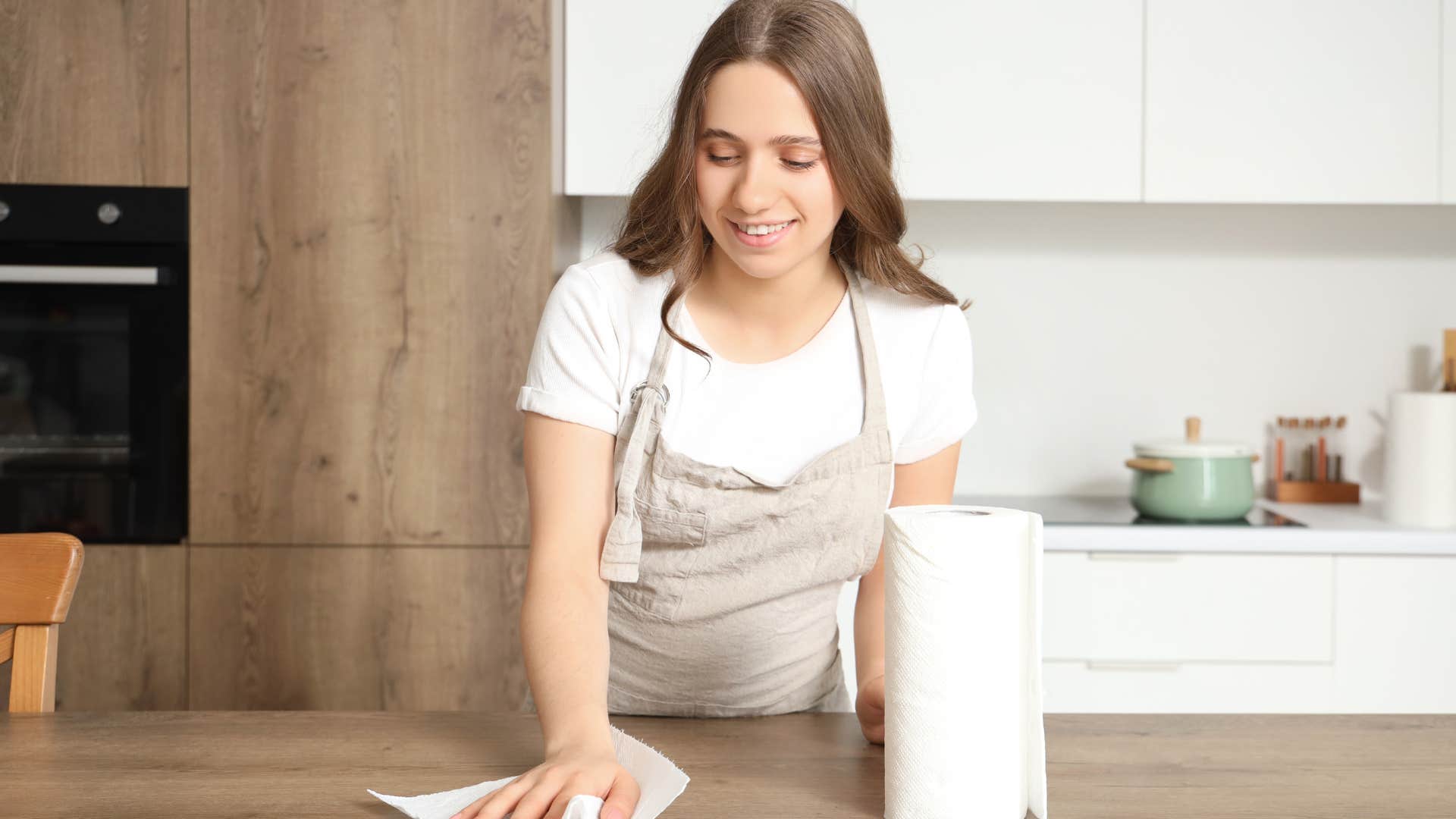11 Things People From Working-Class Backgrounds Never Waste Money On
Their experiences from early in life inform their financial mindset today.
 Daniel Hoz | Shutterstock
Daniel Hoz | Shutterstock Many people from working-class backgrounds grew up without financial freedom and stability, leaning on budgeting and frugal habits to survive. This mindset, like many other childhood or early adult experiences, follows people into adulthood, informing the way they spend, save, and interact in the economic landscape, like a study from the Journal of Family and Economic Issues suggests.
Many of the things people from working-class backgrounds never waste money on are informed by this mindset. They still have lingering symptoms of this survival mindset that protects them from falling victim to pressures for status, external validation, comfort spending, and advertisements. Compared to people from wealthy backgrounds, they tend to be far more aware and intentional of their financial habits.
Here are 11 things people from working-class backgrounds never waste money on
1. Designer clothes
 maxbelchenko | Shutterstock
maxbelchenko | Shutterstock
Designer clothes and home decor are some of the things people from working-class backgrounds never waste money on, not just because they're grossly overpriced, but because the quality just isn't worth it. Despite many misguided societal beliefs that price somehow equals quality, many designer brands are deteriorating in terms of longevity.
Working-class people largely grew up without the ability to fall victim to advertising and yearning for prestige, so now that they may have the money to spend, it's become a habit to avoid.
2. Decorations for every season
 Monkey Business Images | Shutterstock
Monkey Business Images | Shutterstock
From new holiday decorations every year to seasonal decor, people from working-class backgrounds aren't overspending on home decor that's not functional or necessary. According to a Rocket Homes survey, the average person spends nearly $300 on holiday decorations alone and another $550 on gifts for their loved ones.
Of course, people from low-income and working-class backgrounds want to be able to enjoy these sentimental moments and spend on their loved ones if they have the freedom to. But investing in decorations for approval, validation, or comfort isn't on their radar.
3. Subscriptions
 Jelena Zelen | Shutterstock
Jelena Zelen | Shutterstock
The average person spends nearly $150 annually on streaming services alone, according to a survey from Consumer Reports, despite using only a handful of them. Alongside other subscriptions, like grocery delivery, food delivery apps, and other online services, the cost of these things can quickly add up and become a financial burden.
However, working-class people tend to avoid subscriptions, in general. If they're investing in streaming, they stick to one service, only buying what they need to avoid wasteful spending.
4. Single-use products
 Pixel-Shot | Shutterstock
Pixel-Shot | Shutterstock
While many other people spend for convenience, working-class people don't mind learning new skills, investing more time, or using more energy to save money. They've grown accustomed to learning how to fix household repairs or spend extra time cleaning reusable dishes, so they're not constantly fighting the battle of seeking ease and convenience in their lives today.
From toilet paper, to single-use water bottles, plastic bags, and utensils, people regularly using single-use products aren't just spending more every month, they're also indulging an environmentally irresponsible habit that negatively impacts everyone.
5. Coffee
 RossHelen | Shutterstock
RossHelen | Shutterstock
According to a survey from Drive Research, many Americans are spending close to $50 a month on purchasing coffee outside of their home. Largely a convenience habit — they don't want to spend the time and energy making coffee at home — this is one of the things people from working-class backgrounds never waste money on.
Even if that means bulk-making cold brew, creating a coffee routine at home, or learning how to make their favorite latte, working-class people have grown up learning how to make the most of a frugal lifestyle.
6. New cars
 maxbelchenko | Shutterstock
maxbelchenko | Shutterstock
When you drive a new car off the lot, it immediately depreciates by around 9%, and that number only continues to grow the longer you use it. So, realistically, if you're looking for an investment in a car, a brand new vehicle is the worst option, because you'll never sell it for the same price as you paid.
According to a Consumer Reports study, there are a number of reliable cars that working-class people can invest their money into, but for the most part, they avoid buying brand new vehicles. Compared to wealthy people who may purchase cars for status or prestige, not worried about how much money they're actually wasting, this is one of the things people from working-class backgrounds never waste money on.
7. Groceries
 ViDI Studio | Shutterstock
ViDI Studio | Shutterstock
There are a number of frugal habits in the grocery store that people from working-class backgrounds leverage to save money. From couponing, to loyalty programs, waiting for deals, and planning ahead, they're intentional with how much they spend on food, especially in the current economy, where food prices are dramatically rising.
Compared to wealthy people, who may splurge at luxury grocery stores, buying overpriced organic foods, working-class people know how to budget and save when they make a trip to buy their food.
8. Bottled water
 afotostock | Shutterstock
afotostock | Shutterstock
Rather than constantly overspending on single-use waters and fancy bottles from luxury grocery stores, people from working-class backgrounds invest in one single reusable option. According to a study conducted by Penn State University, the average American spends nearly $1,300 on single-use plastic water bottles a year, even amid a resurgence and popularization of reusable options.
So, it's not just a frugal choice to opt for a cheaper reusable alternative, it's also environmentally more feasible, helping to reduce plastic and waste.
9. Eating at restaurants
 Kostiantyn Voitenko | Shutterstock
Kostiantyn Voitenko | Shutterstock
While they might go out once a week or to celebrate an event, people from working-class backgrounds aren't constantly eating out at restaurants. Even when it comes to delivery, they're more likely to go to the grocery store and make a meal than spend extra getting a single meal delivered to their doorstep.
According to a OnePoll survey, the average American spends more than $2,500 annually eating at restaurants — a chunk of change that people from working-class backgrounds could better save and invest elsewhere with the right mindset and habits.
10. The newest iPhone
 Prostock-studio | Shutterstock
Prostock-studio | Shutterstock
Many people fall victim to social pressures, advertisements, and peer pressure urging them to purchase the "next best thing." In our current society with an ever-evolving trend cycle, it could be anything — from clothing, to a technology device, and even a water bottle.
While some people overspend to grasp the belonging consumerism offers them, people from working-class backgrounds know how to stick to their frugality even in the face of complex emotions. They're not buying the newest iPhone for external validation or to fit in with a group who values status, but instead planning, saving, and intentionally crafting a financial stability that suits their best interests.
11. Expensive weddings
 PeopleImages.com - Yuri A | Shutterstock
PeopleImages.com - Yuri A | Shutterstock
According to a Fidelity study, the average American spends more than $33,000 on their wedding, largely because it's become a social norm to invest tons of money into this big day. However, working-class people aren't ignorant to the importance and insanity of a lump sum of money like that and would prefer to save and invest it elsewhere.
That doesn't mean they don't still spend money and invest energy into making their wedding day special, they're just far more intentional about avoiding overspending on things that won't serve them in the long run.
Zayda Slabbekoorn is a staff writer with a bachelor’s degree in social relations & policy and gender studies who focuses on psychology, relationships, self-help, and human interest stories.

